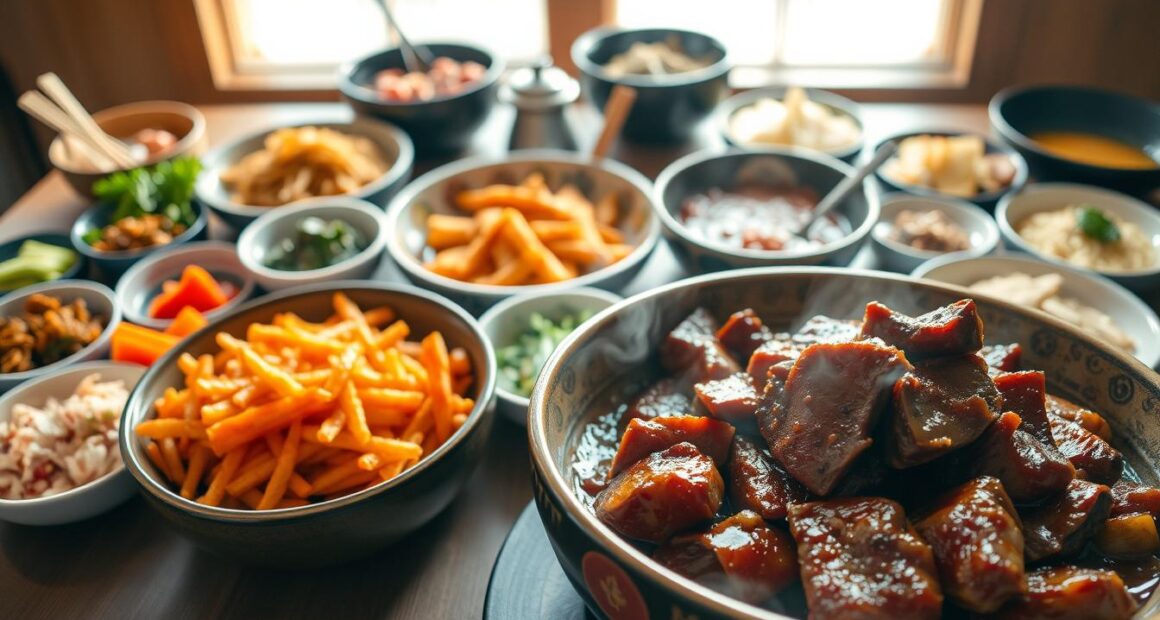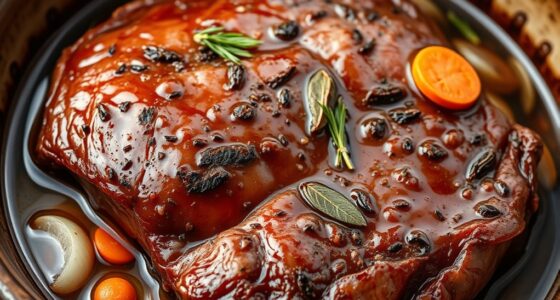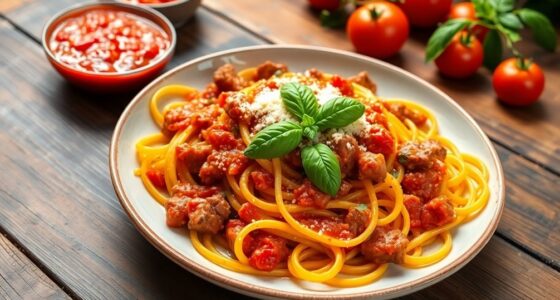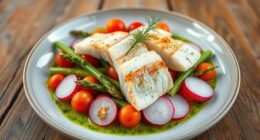As you embark on your culinary journey through the vibrant landscape of Korean cuisine, take a moment to reflect on the emotions tied to food—how a memorable meal can evoke nostalgia for home, warmth during gatherings, or excitement for new adventures. The world of Korean food is rich with layers of flavors that can transport you to bustling street markets in Seoul or cozy family kitchens filled with the intoxicating aroma of sizzling meats and spices. Each dish tells a story, blending tradition with innovation, making it essential to explore the best Korean dishes and popular Korean dishes that have delighted taste buds for generations. Ready your palate for a selection of savory delights, from the iconic kimchi to unexpected treasures. Let’s dive into some unforgettable Korean food recipes that promise to deepen your appreciation for this remarkable cuisine.
Key Takeaways
- Korean cuisine offers a diverse palette of flavors, blending traditional and modern practices.
- Must-try dishes like kimchi and bibimbap are staples in both traditional and contemporary dining.
- Street foods such as tteokbokki showcase Korea’s culinary heritage and creativity.
- Korean BBQ provides a unique experience, with an emphasis on grilling and fresh ingredients.
- Banchan, or side dishes, play a crucial role in every meal, enriching the dining experience.
What is Korean Cuisine?
Korean cuisine stands out for its vibrant flavors and the variety of ingredients that characterize its dishes. Unique aspects of korean food culture reflect the geography and climate of Korea, influencing what ingredients are available each season. This evolution led to a rich tapestry of flavors centered around rice, vegetables, and meats. Traditional Korean cuisine often features staple dishes paired with side dishes known as banchan, which round out the meal and enhance the dining experience.
An Introduction to Flavors and Ingredients
The essence of traditional korean cuisine lies in its bold use of spices and ingredients. Staples like rice are accompanied by an assortment of vegetables and meats, all seasoned to create dishes that burst with flavor. The amount of rice consumed has seen a decline in recent years, but it remains central to the dining experience. Interesting facts highlight this shift; for instance, per-capita meat consumption has steadily increased over the decades, showcasing a growing preference for protein-rich meals.
Unique Cooking Techniques
Korean cooking techniques are deeply rooted in the culture, emphasizing the importance of preserving flavors through methods like fermenting, grilling, and stewing. The art of kimjang, the process of making kimchi, has even been recognized by UNESCO as an Intangible Cultural Heritage. Notably, the communal aspect of dining is essential in korean food culture, where meals are often shared among family and friends, enhancing the enjoyment of food and togetherness. Understanding these practices gives insight into why korean cuisine is cherished both in Korea and internationally.

The Importance of Kimchi
Kimchi holds a vital place in Korean cuisine and culture. This fermented dish has over 200 variations, each with unique ingredients, flavors, and preparation methods. Baechu kimchi, made from napa cabbage, represents over 70% of the kimchi market, reflecting its status as a staple in Korean meals. You can find other types of kimchi, such as kkakdugi, made from white radish, which makes up about 20% of the kimchi vegetable used. Kimchi not only enhances the flavors in popular korean dishes but also embodies the essence of authentic korean recipes.
Types of Kimchi You Should Try
Exploring different types of kimchi can be a delightful culinary adventure. Some must-try varieties include:
- Baechu Kimchi: The most iconic, made with napa cabbage and seasoned with chili, garlic, and fish sauce.
- Kkakdugi: Chunky radish kimchi, often enjoyed with beef soup.
- Oisobagi: Cucumber kimchi, refreshing and perfect for summer.
- Chonggak Kimchi: Made with young radish, offering a unique crunch.
Each variant represents a unique flavor experience, enhancing the diversity of korean food recipes you can enjoy.
Health Benefits of Kimchi
This beloved dish does more than just complement your meals; it offers a host of health benefits. Kimchi is rich in probiotics due to the fermentation process, which stimulates gut health and aids digestion. Regular consumption of kimchi contributes to a balanced diet as it is low in calories and high in essential vitamins, like vitamin C and K. Studies suggest that kimchi consumption is linked to improved health and longevity among Koreans. Including kimchi in your diet aligns with the idea that enjoying popular korean dishes can greatly support overall wellness.
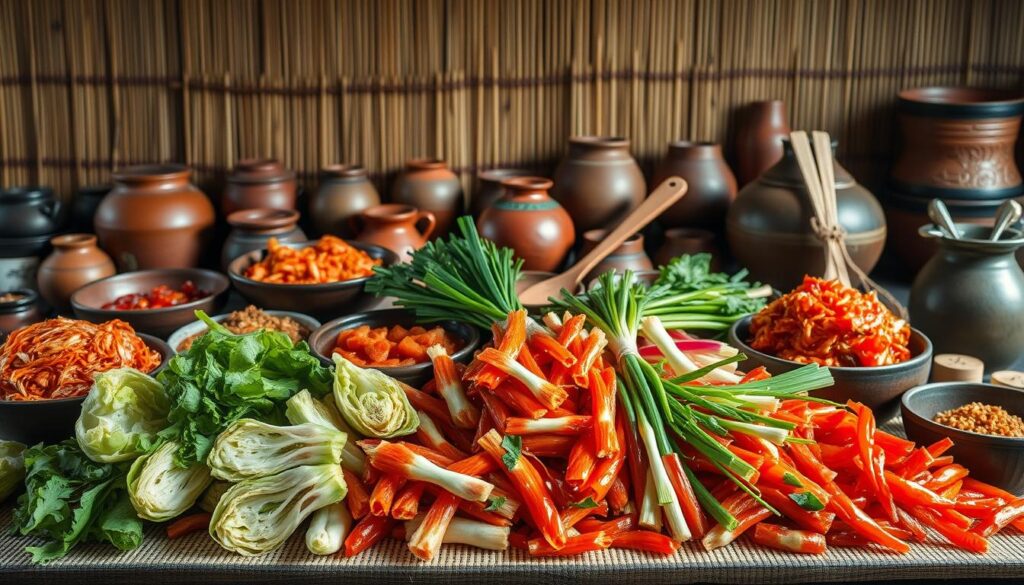
The Comfort of Korean BBQ
Korean BBQ transcends being just a meal; it represents a lively social event where friends and family gather around the grill to enjoy one of the best Korean dishes. This communal dining experience reflects the rich fabric of Korean food culture that emphasizes sharing and togetherness. Diners participate actively in grilling marinated meats, creating a vibrant atmosphere that makes every outing unique.
Essential Items to Grill
At the heart of any Korean BBQ is a selection of premium meats that take center stage. Some of the essential items to grill include:
- Galbi (short ribs) – Recommended in LA-style, flanken-cut for high heat cooking.
- Bulgogi – Thinly sliced sirloin or ribeye marinated in a savory-sweet soy sauce.
- Dwaeji Bulgogi – Pork with a more robust marinade, offering a deeper flavor profile.
- Buldak – Charcoal-grilled chicken prepared with a spicy-sweet sauce, showcasing versatility.
The flavor of the meat plays a crucial role, as prime cuts are often seasoned minimally while tougher cuts benefit from marination. This careful attention to preparation ensures a delectable grilling experience during your next Korean dining event.
Best Condiments and Sides
To complement the grilled meats, an array of condiments and sides enriches your Korean dining experience. Essential items include:
- Ssamjang – A must-have dipping sauce made from doenjang and gochujang.
- Banchan – Small side dishes that offer balance and variety, preventing palate fatigue.
- Lettuce and Perilla Leaves – Used for wrapping grilled meats, providing a fresh contrast.
- Rice – A supportive component that enhances the overall meal.
The lively atmosphere of Korean BBQ, combined with these flavorful additions, creates a holistic experience that not only satisfies the palate but also fosters connections among diners. Engaging with these elements captures the essence of Korean food culture, making every BBQ gathering a cherished memory.
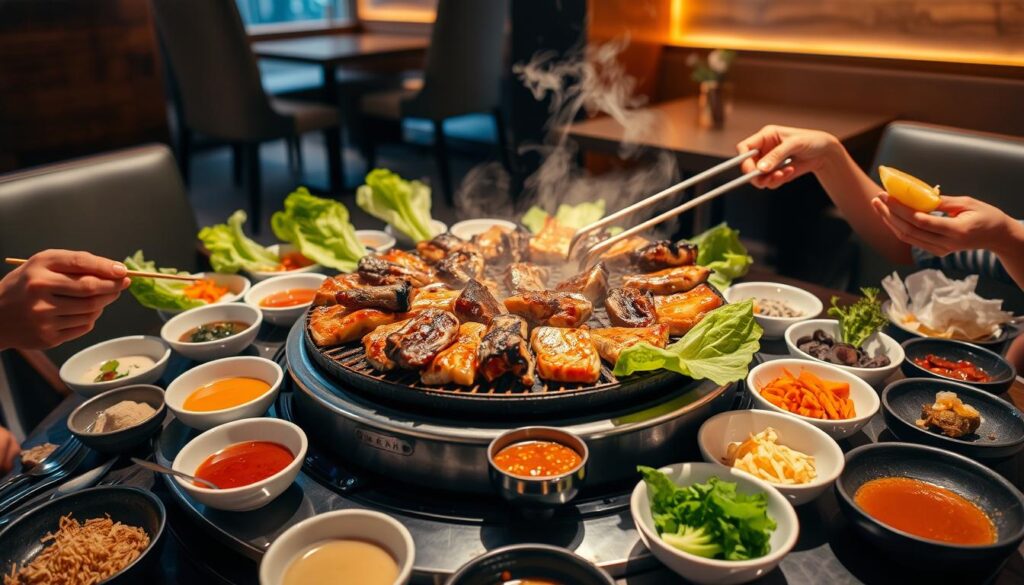
Exploring Bibimbap
Bibimbap, which translates to “mixed rice” in Korean, represents a beautiful harmony of flavors, textures, and colors on a single plate. This dish typically features a base of fluffy steamed white rice topped with a vibrant array of sautéed vegetables, a protein option, and a rich gochujang sauce. The meticulous assembly not only enhances its visual appeal but also celebrates the diverse ingredients essential to Korean food. You can find it served in some of the top korean restaurants and it’s a fantastic way to experience the best korean dishes.
Components of a Perfect Bibimbap
A well-crafted Bibimbap showcases an assortment of fresh vegetables that contribute vitamins, minerals, and antioxidants to your meal. Here are the key components:
- Steamed white rice as the foundation
- A color palette of sautéed vegetables like carrots, spinach, and bean sprouts
- Your choice of protein, including traditional beef bulgogi, tofu, or a fried egg
- A drizzle of the flavorful gochujang sauce
Bangbop, a popular choice among korean food recipes enthusiasts, offers signature bowls that cater to various tastes. Options like the Traditionalist bowl highlight seasonal Korean veggies paired with bulgogi, while the Gyopo chicken Bibimbap introduces mozzarella cheese and avocado for a modern twist.
Recommended Toppings
The beauty of Bibimbap lies in its versatility. Here are recommended toppings that elevate your experience:
| Topping | Description |
|---|---|
| Sautéed Mushrooms | Adds an earthy flavor and soft texture |
| Picked Vegetables | Offers a tangy contrast to the other ingredients |
| Sesame Seeds | Provides a nutty taste and a crunchy texture |
| Fried Egg | Brings richness with a beautifully runny yolk |
Enjoying Bibimbap often occurs as a communal meal, emphasizing the importance of sharing. Mixing the ingredients allows a blend of flavors that creates a unique culinary experience. With its longstanding significance in Korean cuisine and adaptability, Bibimbap remains a celebrated must-try dish, whether you’re indulging at home or seeking it out in the best korean restaurants.
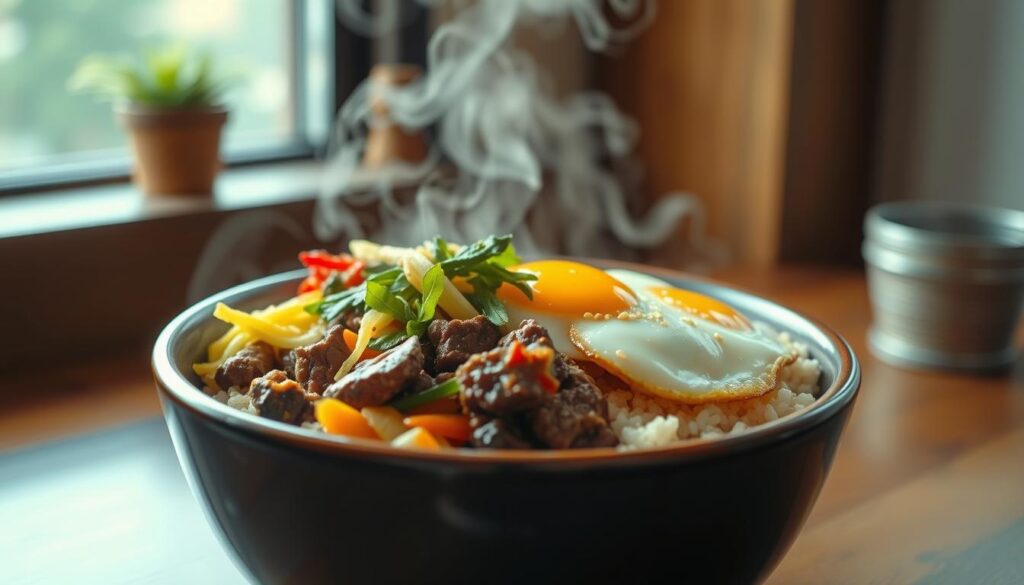
Tangy and Delicious Guk
Korean soups, known as guk, play a significant role in korean food culture, providing warmth and comfort during meals. These delightful soups feature a variety of ingredients, showcasing the diversity of traditional korean cuisine. Among the most notable options are kimchi jjigae and sundubu-jjigae. Each soup combines broth, vegetables, and protein, making them not only flavorful but also packed with nutritional benefits.
Different Types of Korean Soups
Here are some of the best korean dishes in the guk category:
| Soup Name | Main Ingredients | Cooking Time | Serves |
|---|---|---|---|
| Kimchi Jjigae | Kimchi, pork, tofu, green onions, hot pepper paste | 40 minutes | 2-3 people |
| Sundubu-jjigae | Soft tofu, seafood, vegetables, egg | 30-35 minutes | 2-3 people |
| Seolleongtang | Ox bones, noodles, green onions, garlic | 10 hours | 4-6 people |
| Gamjatang | Pork bones, potatoes, napa cabbage, perilla leaves | 2 hours | 4-5 people |
Nutritional Benefits of Guk
Incorporating guk into your diet offers numerous advantages. These soups often provide essential nutrients and can help you maintain a balanced diet. Ingredients like kimchi not only add flavor but also contribute to digestive health and overall wellness. Embracing these dishes enhances your understanding of traditional korean cuisine while enjoying some of the best korean dishes available.
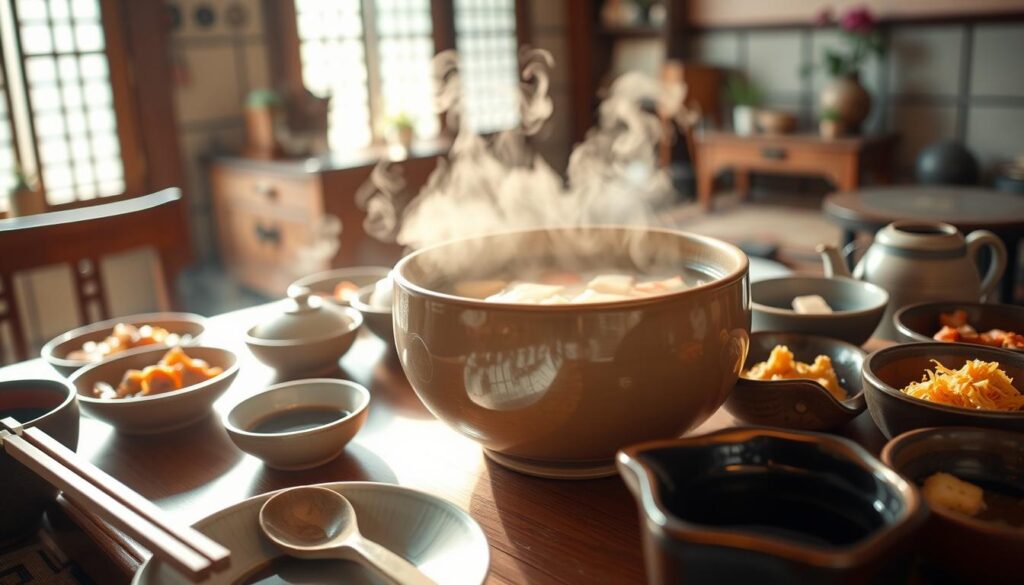
Discovering Tteokbokki
Tteokbokki stands as one of the most beloved street foods in Korea, known for its chewy rice cakes drenched in a spicy-sweet sauce. This dish boasts a rich history, having transitioned from a royal court delicacy to a popular snack enjoyed on bustling streets. The growing interest in Korean culture, driven by K-pop and Korean cinema, has elevated tteokbokki to the forefront of popular korean dishes in the United States.
How Tteokbokki is Made
Preparing authentic tteokbokki typically takes about 20 to 30 minutes. The primary ingredient, garaetteok, is complemented by fish cakes and scallions, creating a hearty base. Modern takes often introduce variations, including:
- Haemul-tteokbokki – featuring seafood for a delightful twist
- Ra-bokki – incorporating ramen noodles for added texture
- Jjol-bokki – made with jjolmyeon, providing a unique flavor
While the traditional sauce includes gochujang, known for its spiciness, many enjoy a milder version using gungjung sauce. The versatility of tteokbokki allows for creativity, letting you customize the dish according to your taste preferences.
Variations and Flavor Profiles
The flavor profile of tteokbokki is largely influenced by its sauce and additional ingredients. As its popularity surges, particularly among Western audiences, numerous restaurants, like Yup Dduk and new ventures such as Witch Topokki, are capitalizing on this trend. The addition of Cheongyang pepper in some dishes can elevate the spice level to 10,000 Scoville heat units, appealing to adventurous eaters.
In recent years, sales of tteokbokki products by O’Food have increased by 450% in the U.S., showcasing its rising appeal. The dish has surpassed many popular snacks, even alternating in sales rankings with Quaker rice cakes on Amazon. This incredible growth reflects not only the dish’s delectable flavors but also its cultural significance as an authentic korean recipe.
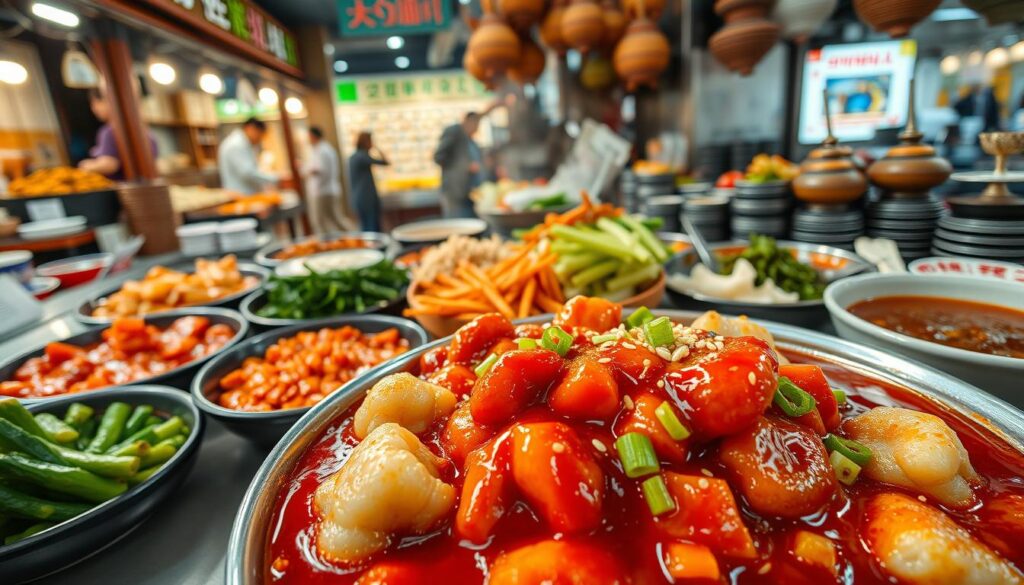
Savoring Japchae
Japchae is a beloved offering within traditional korean cuisine, enchanting diners with its delightful blend of flavors and textures. This savory-sweet dish originates from the Joseon Dynasty, having been enjoyed by nobility before becoming a staple in Korean food culture. At its core, Japchae features chewy sweet potato noodles, known as dangmyeon, combined with a selection of colorful vegetables and often a protein such as beef or tofu. You can’t help but savor each bite.
Key Ingredients in Japchae
Each ingredient plays a vital role in crafting this remarkable dish. The foundational component is eight ounces of sweet potato starch noodles, which require soaking in cold water for about 40 minutes before cooking. Then, the magic truly begins with the addition of a variety of mushrooms—using twelve to sixteen ounces of shiitake, oyster, maitake, enoki, and crimini mushrooms elevates the dish. You’ll also need one large onion, one to two large carrots, and four to six scallions, cut into 2.5-inch pieces.
The cooking oil serves as a medium; 1/4 cup of olive oil and 1/4 cup of water are perfect for sautéing the vegetables. A sauce made from 2 tablespoons of brown sugar, 1/4 cup of soy sauce, and three to five cloves of minced garlic brings all the elements together. Finishing touches include a sprinkle of sesame seeds and a drizzle of sesame oil, both of which enhance the flavor and presentation.
When and How to Serve Japchae
Japchae can be enjoyed during various occasions, particularly as a side dish during celebrations, showcasing its significance in korean food culture. It symbolizes longevity and prosperity, making it a popular choice at festive gatherings. When serving Japchae, consider pairing it with a side of rice or offering it as a standalone dish for a complete meal. The adaptability of this dish allows for variations; whether it’s a traditional meat-based version, a vegetarian delight, or even a spicy rendition, Japchae can cater to diverse tastes.

The Delight of Banchan
In the vibrant landscape of korean food culture, banchan stands out as an essential aspect of the dining experience. These delightful side dishes accompany the main course, offering an array of flavors, textures, and colors that enhance your overall korean dining experience. Banchan not only showcases regional ingredients but also reflects the seasonal changes of Korea’s rich culinary heritage.
Common Banchan Dishes
- Kimchi: The quintessential banchan, bursting with flavor and health benefits.
- Dried Radish: Often prepared in finger-sized sticks, providing a chewy texture.
- Oi Muchim: This spicy cucumber salad complements many dishes, especially Korean BBQ.
- Pan-fried Zucchini: A quick and easy side, perfect for busy mealtimes.
- Pickled Garlic: Prepared by boiling vinegar, sugar, and soy sauce with cleaned garlic.
- Gamja Jorim: These soy sauce braised baby potatoes appeal to younger audiences.
- Jangjorim: A savory soy sauce braised dish that has gained popularity.
- Tuna Pancakes: Known as chamchijeon, these are loved by both children and adults.
The Role of Banchan in Meals
Banchan serves a crucial purpose in enhancing meals by providing variety and balance. Each dish complements the main dish, contributing to the overall flavor profile. The experience of sharing these side dishes reflects a warm and communal aspect that is essential in korean food culture. You can enjoy a tactile and immersive dining experience with an assortment of sides that change with the seasons, ensuring a tapestry of tastes in every meal. As Korean cuisine gains popularity in the U.S., these side dishes have become part of the best korean dishes, making their way into the hearts—and stomachs—of many.
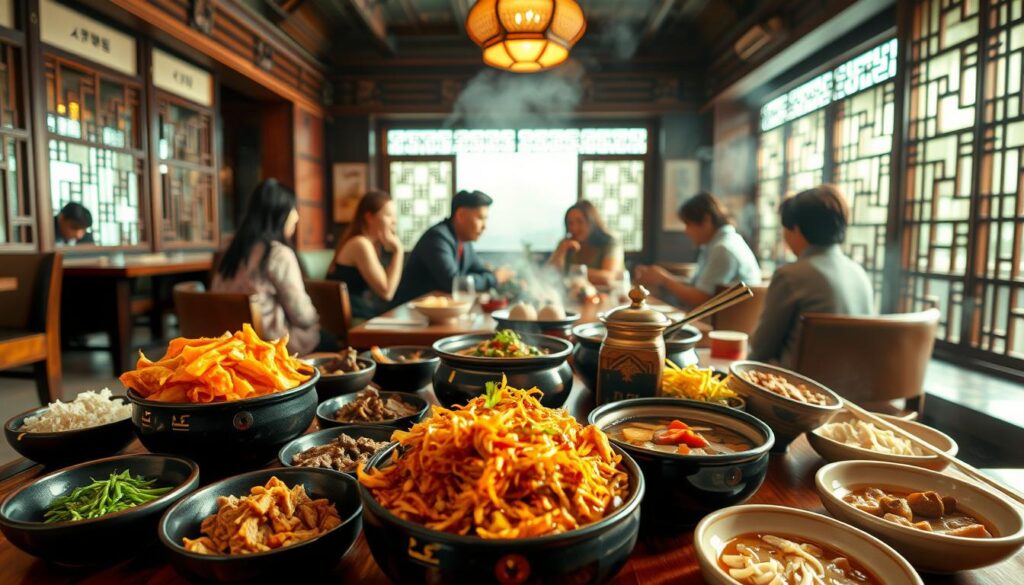
Unpacking Jjigae
Jjigae stands as a beloved staple in Korean dining, representing comfort and warmth in a bowl. These flavorful stews feature a variety of ingredients and are perfect for sharing with friends and family, making them some of the most popular Korean dishes. Two prominent types include kimchi jjigae and budae jjigae, showcasing the depth and diversity of Korean food recipes.
Popular Types of Jjigae
When exploring jjigae, you will find several exciting varieties:
- Kimchi Jjigae: Made with old kimchi, this dish highlights the tanginess and depth of fermented flavors. It’s often prepared with pork belly and tofu, creating a rich experience.
- Budae Jjigae: Also known as army base stew, this dish combines an array of canned goods with traditional staples. It’s a unique and hearty dish that emerged from the Korean War.
- Sundubu Jjigae: This soft tofu stew shines with its delicate ingredients, often served with seafood and a spicy broth that warms the soul.
Serving Options for Jjigae
Typically, jjigae is served bubbling in a hot pot, accompanied by a bowl of steamed rice for balance. Here are a few serving suggestions to enhance your dining experience:
- Pair with banchan for an authentic meal, offering a selection of side dishes that complement the flavors of the stew.
- Add garnishes like chopped green onions or toasted sesame seeds to the top for an extra touch.
- For a more filling option, serve with an assortment of noodles to soak up the savory broth.
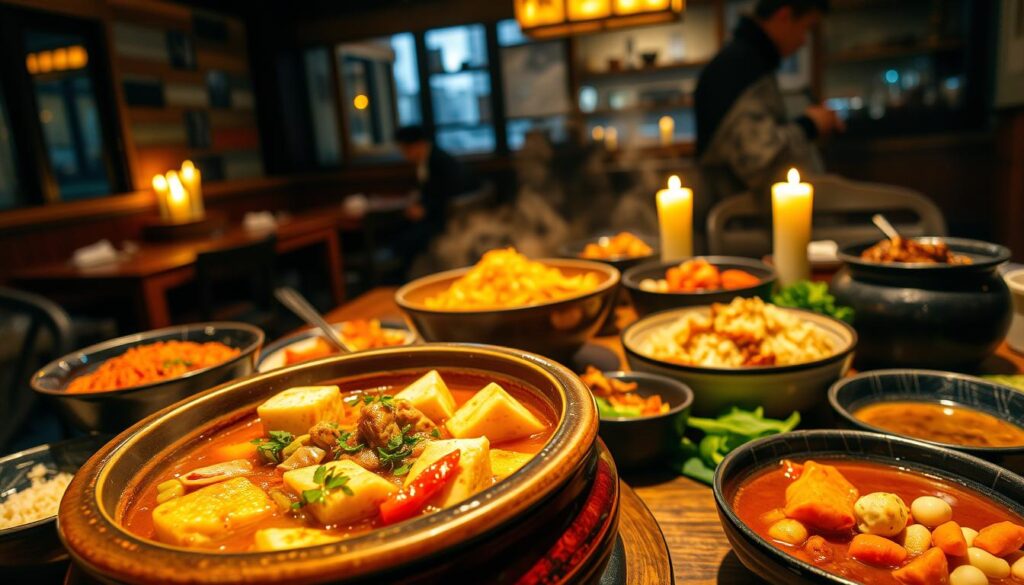
Taste the Sweetness of Mandu
Mandu stands out in korean food culture as a delightful dumpling filled with savory ingredients. Originating from Korea’s rich culinary history, mandu can be served in a variety of ways, appealing to different tastes and preferences. Understanding the types of mandu available enhances your experience and appreciation for these delicious bites. You can discover authentic korean recipes that showcase this versatile dish and contribute to your journey of exploring the best korean dishes.
Types of Mandu You Can Enjoy
- Jjin-mandu: Steamed dumplings often considered softer in texture.
- Mul-mandu: Boiled dumplings that are juicy and tender.
- Gun-mandu: Pan-fried dumplings with a crispy exterior.
- Wang mandu: Larger variations filled with an array of ingredients.
- Pyeonsu: Thin dumplings that are delicately wrapped.
- Kimchi-mandu: Spicy dumplings enhanced with kimchi for a flavor kick.
Cooking Methods for Mandu
The method of preparation greatly affects the flavor and texture of mandu. Here are the popular cooking methods:
| Cooking Method | Description | Cooking Time |
|---|---|---|
| Steamed (Jjin-mandu) | Soft and juicy with a tender wrapper | 7 minutes |
| Boiled (Mul-mandu) | Light and flavorful; cooked in boiling water | 5-6 minutes |
| Pan-fried (Gun-mandu) | Crispy on the outside; golden brown finish | 10-12 minutes |
| Deep-fried | Crunchy texture; often served as a snack | 8-10 minutes |
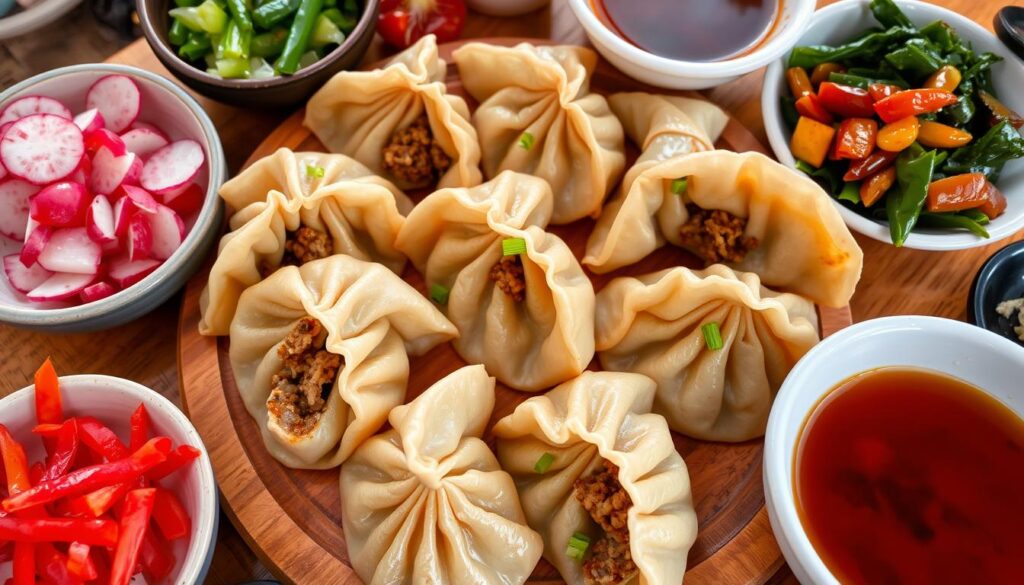
Understanding Korean Desserts
Korean desserts are a delightful blend of tradition and innovation, reflecting the rich culinary heritage of the country. These sweets often feature ingredients such as sweet rice and red beans, presenting unique textures and flavors. You can find both traditional options and modern takes that embrace global influences, offering a diverse experience for dessert lovers. Engaging with these sweets provides insight into the evolving nature of korean food recipes while highlighting some of the best korean dishes.
Must-Try Traditional Desserts
Among the favorites in Korean dessert culture, patbingsu stands out with its stunning presentation and refreshing taste. This shaved ice treat is topped with sweet red bean paste, fruit, and condensed milk, making it one of the most popular korean dishes during summer. Hotteok, a sweet pancake filled with brown sugar syrup, is often enjoyed as street food during the winter months, showcasing its importance in seasonal celebrations.
- Songpyeon: Crescent-shaped rice cakes filled with sweet red bean paste, traditionally served during the Chuseok festival.
- Tteok: These rice cakes come in numerous varieties, with hundreds enjoyed year-round.
- Yaksik: A glutinous rice dish mixed with sweet fillings, often enjoyed during special occasions.
Modern Takes on Korean Sweets
Modern interpretations of korean food recipes have led to innovative desserts that blend tradition with contemporary flavors. For example, bungeo-ppang consists of a fish-shaped pastry filled with sweetened red bean paste, catering to both young and old with its fun shape and familiar flavor. Hoppang, the convenience food version of jjinppang, also fills a similar niche.
The rise of desserts like dasik, matcha green tea cookies made with roasted rice flour, indicate the influence of global ingredients intertwined with traditional recipes, making these popular korean dishes ever-evolving.
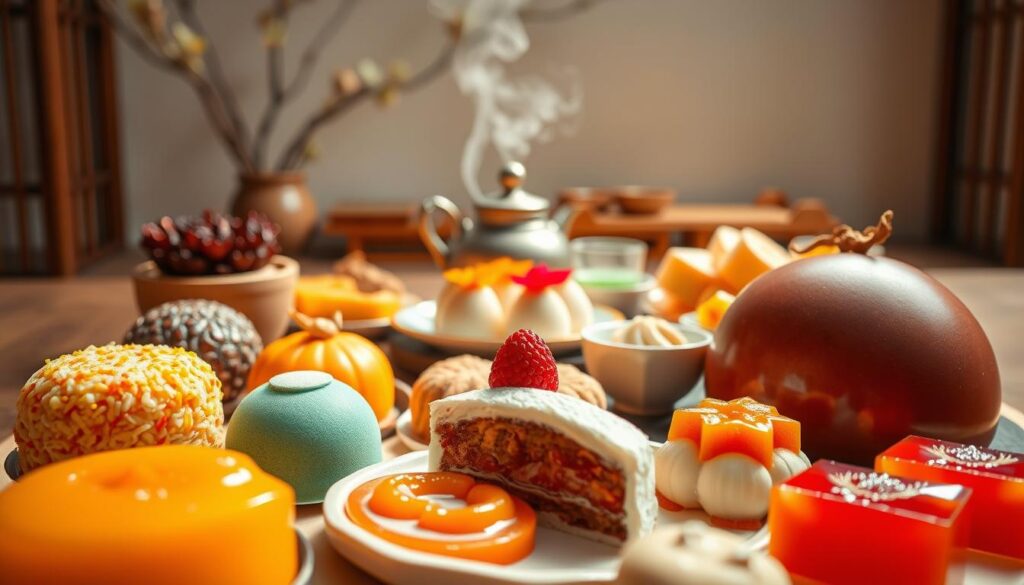
Where to Enjoy Korean Cuisine in the U.S.
Korean cuisine is rapidly becoming a staple in the dining scene across the United States, with an increasing number of top Korean restaurants setting up shop. From vibrant Seoul Garden locations in North Carolina to the bustling ambiance of Dae Gee Korean BBQ in Colorado, you’ll find a rich tapestry of flavors that reflect the traditional and modern aspects of Korean food culture. Enjoying these culinary delights allows you to immerse yourself in the vibrant community that celebrates this fascinating cuisine.
Popular Korean Restaurants to Visit
When seeking a complete Korean dining experience, consider visiting Genwa Korean BBQ in Los Angeles, known for its quality meats and exceptional service. Not far behind, Ssal offers a constantly evolving tasting menu rooted in traditional ingredients but executed with a modern flair. For dessert lovers, Myomee Cafe’s bingsu is a must-try, while those in search of a casual eat can head to BopNgrill in Chicago for Korean-style fast food that’s bursting with flavor.
Tips for Dining at Korean BBQ
To truly enjoy the Korean BBQ experience, order a variety of meats to grill at your table, and don’t forget to indulge in the banchan—a selection of small side dishes that perfectly complement your meal. Experimenting with different dipping sauces can elevate your dining adventure. Remember, sharing is key in Korean food culture, so gather your friends and dive into the delightful world of flavors. Discovering Korean cuisine is not just about the food, but the vibrant experience of enjoying it together.
